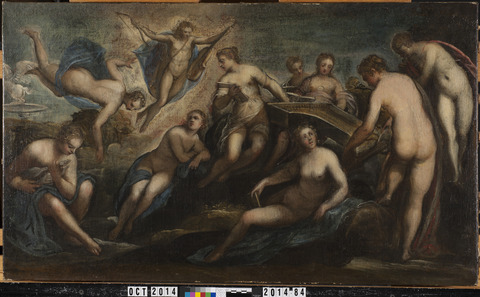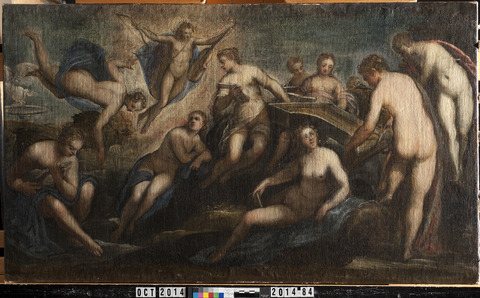Overview
Identification number: 2014.82
Artist: Workshop of Jacopo Tintoretto (Domenico Tintoretto?)
Title: Apollo and the Muses
Materials: Oil (untested) on canvas
Date of creation: About 1580
Previous number/accession number: C10073
Dimensions: 55 × 93.2 cm
Conservator/examiner: Fiona Beckett with contributions from Roxane Sperber
Examination completed: 2014, revised 2021
Distinguishing Marks
Front:
None
Back:
Item 1. Inscription “241,” handwritten on the crossbar, brown-red crayon (tech. fig. 1).
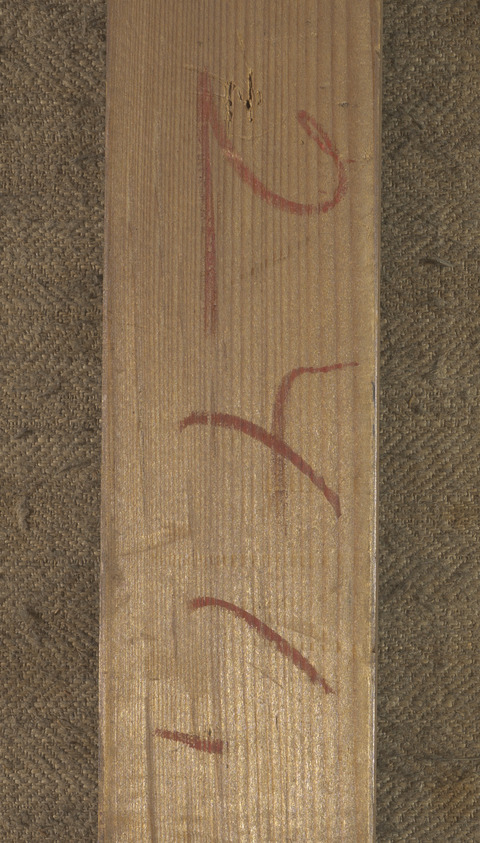
Item 2. “49 I” handwritten in dark blue crayon on upper stretcher bar (tech. fig. 2).

Item 3. “108-109” handwritten in black crayon on right stretcher bar; blue crayon “1518” scratched out in black crayon (tech. fig. 3).
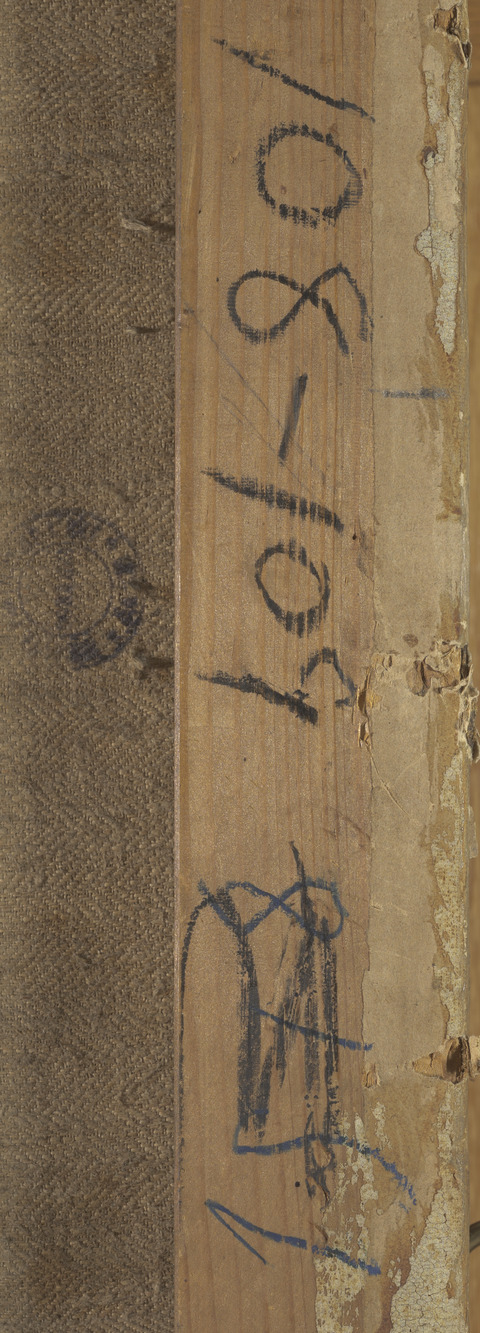
Item 4: Two white labels with red border, upper left: “6734 34” and “6005 4” scratched out (tech. fig. 4).
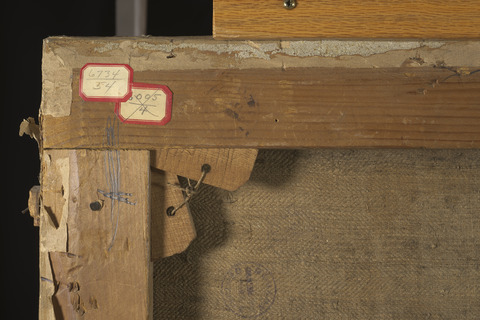
Item 5. Stamp, lower-left stretcher bar, black: “DOUANES-EXPOSITION PARIS” (tech. fig. 5).
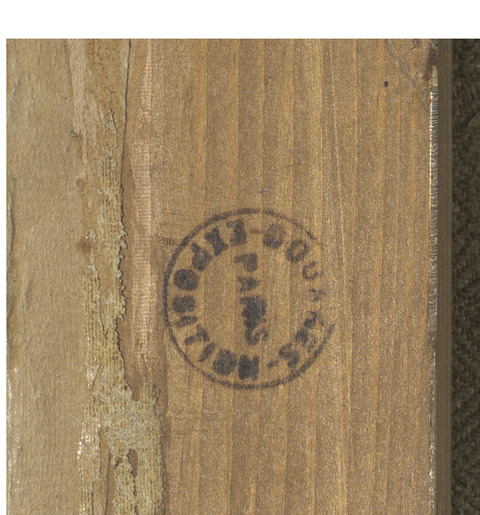
Item 6: Stamp, back of canvas, upper-left corner, purple, illegible (tech. fig 6).
Item 7: Stamp, back of canvas, upper-left corner, gray, illegible (tech. fig 6).
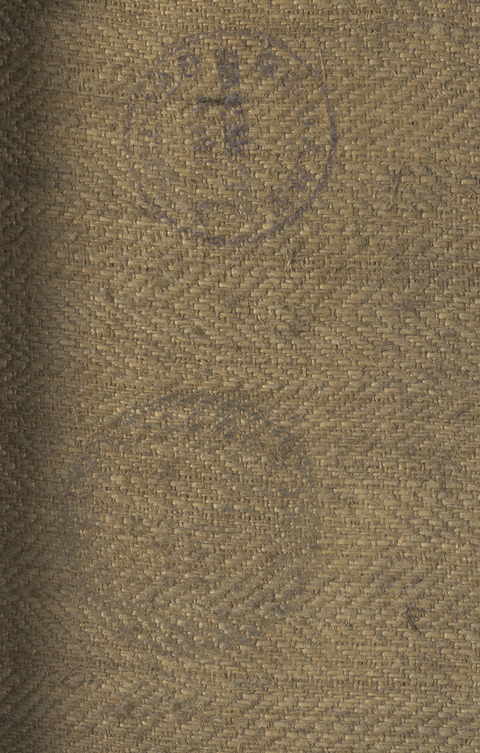
Item 8. Stamp, back of canvas, lower left, purple: “DOUANES-EXPOSITION PARIS” (tech. fig. 7).

Item 9. Stamp back of canvas, center right, purple, illegible (tech. fig. 8).
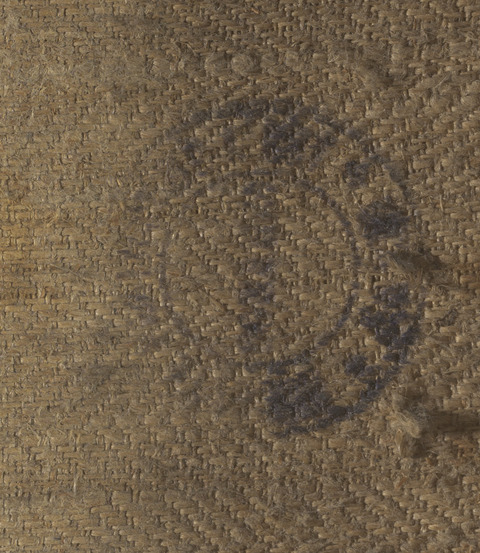
Summary of Treatment History
Physical evidence suggests the painting was treated prior to its arrival at the IMA on long-term loan in 1971. Evidence of past treatments includes the application of a glue lining, fills, and retouching. It was likely treated several times as evidenced by several campaigns of varnish and retouching.
Documentation suggests a series of condition assessments and treatments were carried out on the collection around the time the works were moved from the Clowes residence to the IMA in 1971. A condition report by Paul Spheeris in October of that year, likely carried out before the paintings were relocated, described the frame as being in bad condition. He did not recommend treating the painting.1 A second condition assessment was carried out upon arrival of the paintings at the IMA. This assessment describes the work as being in good condition and not in need of any conservation treatment. Lifted areas of paint were reattached at this time.2
In 1974, a condition assessment, treatment, and investigation of the collection was carried out by the Intermuseum Conservation Association at Oberlin College. Their assessment disagreed with the previous examiners and described the painting as having a discolored yellow varnish that was applied unevenly with glossy spots and a hazy film. A treatment that involved removing the surface coating and overpaint as well as relining the painting was recommended.3 It is unclear if that treatment was carried out, but physical evidence on the painting suggests this is unlikely.
The painting was examined and the condition documented in the annual Clowes Reports from 2011 to 2019.
Current Condition Summary
Aesthetically, the painting is in poor condition due to discolored varnish, significant areas of discolored retouching, and old losses with pronounced textural differences. Areas of abrasion in the paint layers are also visible. Structurally the painting appears sound, with the glue lining intact and no discernible areas of instability.
Methods of Examination, Imaging, and Analysis
| Examination/Imaging | Analysis (no sample required) | Analysis (sample required) |
|---|---|---|
| Unaided eye | Dendrochronology | Microchemical analysis |
| Optical microscopy | Wood identification | Fiber ID |
| Incident light | Microchemical analysis | Cross-section sampling |
| Raking light | Thread count analysis | Dispersed pigment sample |
| Reflected/specular light | X-ray fluorescence spectroscopy (XRF) | Fourier-transform infrared spectroscopy (FTIR) |
| Transmitted light | Macro X-ray fluorescence scanning (MA-XRF) | Raman microspectroscopy |
| Ultraviolet-induced visible fluorescence (UV) | ||
| Infrared reflectography (IRR) | Gas chromatography–mass spectrometry (GC-MS) | |
| Infrared transmittography (IRT) | Scanning electron microscope -energy dispersive X-ray spectroscopy (SEM-EDS) | |
| Infrared luminescence | Other: | |
| X-radiography |
Technical Examination
Description of Support
Analyzed Observed
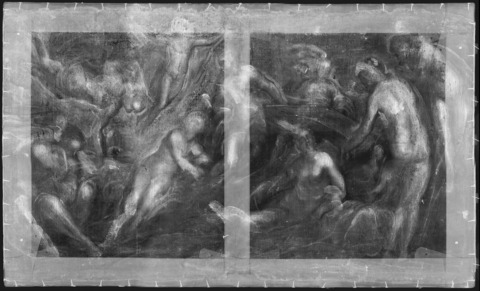
Material (fabric, wood, metal, dendrochronology results, fiber ID information, etc.):
The support is a twill-weave canvas on what appears to be coarse linen with a thread count of 17 × 13 threads per centimeter, with a greater number of threads in the vertical (assumed warp orientation). The individual threads are somewhat incongruous. The lining canvas is composed of a coarser thread that is a more tightly woven twill weave than the original canvas. Twill weave was used as a support on numerous paintings by Jacopo Tintoretto from Venice.4
Characteristics of Construction / Fabrication (cusping, beveled edges of panels, seams, joins, battens):
The original canvas appears to have been constructed of one piece of canvas. No seams are visible in the X-radiograph (tech. fig. 9). Slight cusping is visible along the left edge, but it is difficult to distinguish on the other edges due to the twill weave of the canvas. The painting has been stretched several times. Holes from a previous tacking margin along the bottom edge indicate the painting was cut and restretched to a smaller size in a past treatment campaign. Later, the secondary tacking margins were reincorporated into the current composition to resize the canvas again. The current stretcher is not original.
However, despite being resized several times, the painting is similar in dimensions to the version that was recorded in the engraving by Nicolaus van Hoy in David Teniers the Younger’s Theatrum Pictorium (Antwerp, 1660), documenting Hapsburg Archduke Leopold Wilhelm’s paintings (see tech. fig. 22).
Thickness (for panels or boards):
N/A
Production/Dealer’s marks:
No production or dealer’s marks are present. See Distinguishing Marks for customs stamps located on the back of the canvas and stretcher bars.
Auxiliary Support:
Original Not original Not able to discern None
Attachment to Auxiliary Support:
The painting is glue lined to a herringbone-weave linen canvas and attached to a stretcher with evenly spaced tacks. Brown paper tape is present along all four edges and is somewhat torn. The paper tape does not extend to the front of the painting.
Condition of Support
The canvas is in stable condition despite having suffered significant alteration in the past. The original tacking margins were removed, likely during a previous lining. Later the nonoriginal tacking margins were reincorporated into the composition. The upper and lower edges of the canvas have suffered significant losses, which are filled to match the level of the original canvas. The texture of the fills is flat and does not match that of the canvas, leaving the losses easily identifiable. The adhesion between the lining canvas and the original canvas is intact.
Description of Ground
Analyzed Observed
Materials/Binding Medium:
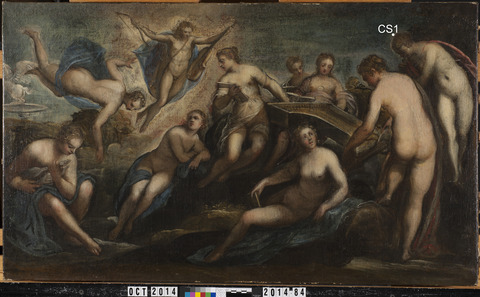
SEM-EDS analysis of cross section 1 (for location see tech. fig. 10) detected calcium and sulfur in the ground layer (tech. figs 11–13; layer 1). This conforms with analysis of the ground layers from Italian paintings at the National Gallery in London, which indicated that Tintoretto typically used calcium sulphate for his grounds.5
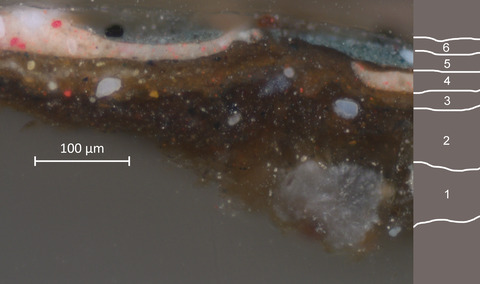
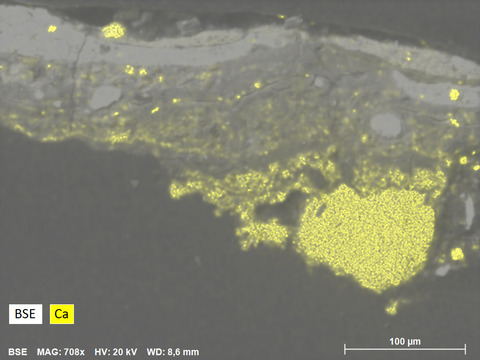
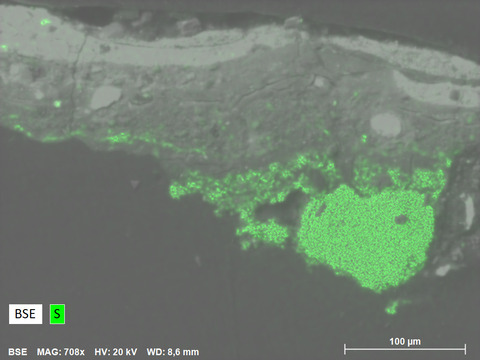
A thick brown imprimatura layer (layer 2) is applied over the calcium sulfate (gesso) ground. A technical study from the National Gallery in London found the brown imprimatura layer on Jacopo Tintoretto’s paintings to contain particles of costly pigments such as ultramarine, vermilion, and red lake pigments. It has been hypothesized that the imprimatura layer was composed of palette scrapings from the studio.6 This does not appear to be the case on this painting where the imprimatura layer is primarily composted of clay rich in alumina-silicates (purple, blue), magnesium (pink), and sodium (gold) (tech. figs. 14–17, layer 2).
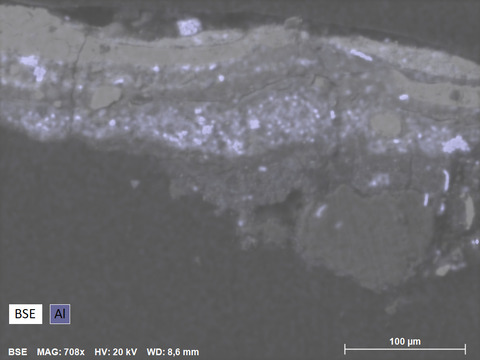
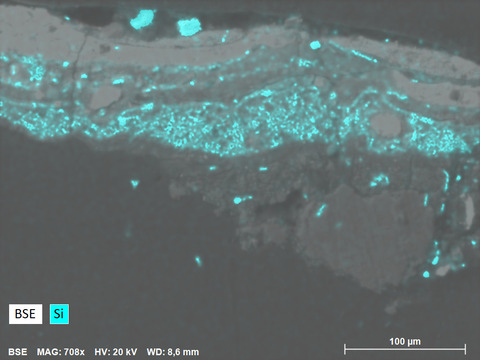
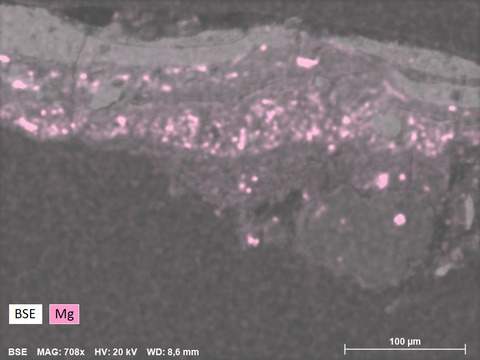
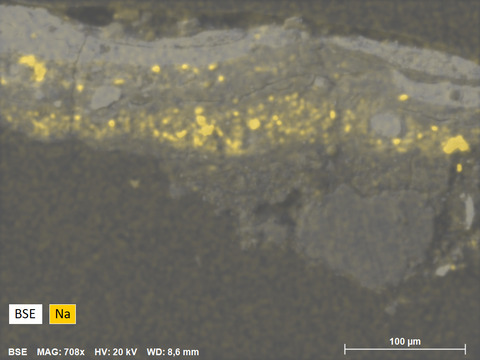
Color:
The ground is an off-white color, which appears to have yellowed slightly over time. A secondary reddish brown imprimatura layer is also visible in cross section 1. This layer appears to have been applied over the entire surface of the painting. This can be seen both in the photomicrographs and in areas of heavy abrasion (tech. fig. 18).
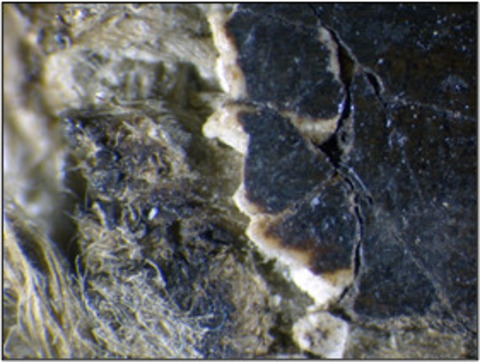
Application:
While no brush or palette knife marks are discernible in the ground layer it was likely brushed evenly over the entire surface.
Thickness:
The ground layer is of medium thickness and appears to be consistent throughout the painting. The imprimatura layer is slightly thinner than the ground but quite substantial for an imprimatura. The imprimatura was likely also applied by brush.
Sizing:
A size layer is not visible in cross section but would have been applied to the canvas prior to the ground layer.
Character and Appearance (Does texture of support remain detectable / prominent?):
The texture of the canvas weave remains prominent through the ground and paint layers. The paint is applied in a manner that involves dragging the paintbrush over the surface of the canvas, allowing the weave texture to become part of the composition.
Condition of Ground
The ground appears to be in stable condition and well adhered to the canvas. Significant areas of previous damage are visible along the perimeter of the painting, particularly the top and bottom, contributing to heavy loss of the ground in these areas. The losses were subsequently filled, although they continue to remain easily distinguishable from the original canvas due to the discrepancy in surface texture.
Description of Composition Planning
Methods of Analysis:
Surface observation (unaided or with magnification)
Infrared reflectography (IRR)
X-radiography
Analysis Parameters:
| X-radiography equipment | GE Inspection Technologies Type: ERESCO 200MFR 3.1, Tube S/N: MIR 201E 58-2812, EN 12543: 1.0mm, Filter: 0.8mm Be + 2mm Al |
|---|---|
| KV: | 20 |
| mA: | 3 |
| Exposure time (s) | 90 |
| Distance from X-ray tube: | 36″ |
| IRR equipment and wavelength | Opus Instruments Osiris A1 infrared camera with InGaAs array detector operating at a wavelength of 0.9-1.7µm. |
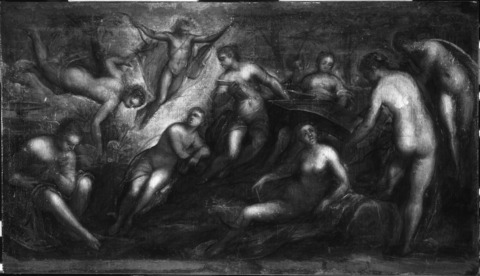
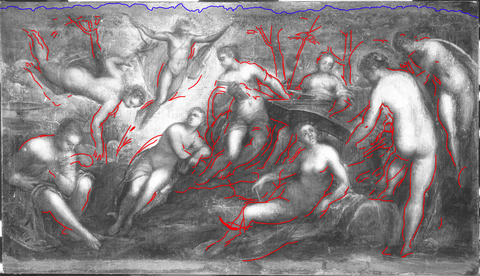
Medium/Technique:
The underdrawing was executed in a fluid, carbon-rich medium applied to the canvas with a brush.
Pentimenti:
When imaged with infrared reflectography, significant underdrawing, including changes to the composition, are visible. Some underdrawing is seen with visible light as the figures were reinforced throughout the painting process. Other areas of underdrawing are only detectable with the infrared camera. It appears that some areas of underdrawing remain obscured by lead white. Notable adjustments in the composition include changes to the trees in the background (which were later painted out of the composition), changes in the position and size of limbs of many of the Muses, and loose suggestive lines where the artist was still developing the composition (tech. fig. 19).
Transmitted infrared reflectography reveals underdrawing and paint layers that were obscured by denser areas of paint (tech. fig. 20). Clear compositional planning as well as several composition changes are visible. These were not as readily discerned by either reflected infrared or radiography. The underpainting was applied in a fluid medium, likely oil paint, and the swift brushwork is a common feature in paintings from the workshop of Jacopo Tintoretto—fitting to the master’s nickname Il Furioso. The figures in the underpainting appear more masculine with pronounced muscles than they do in the uppermost paint layer, another feature of the artist’s painting process (tech. fig. 21). The large amount of underdrawing present indicates that the composition was being developed directly on the canvas rather than copied.
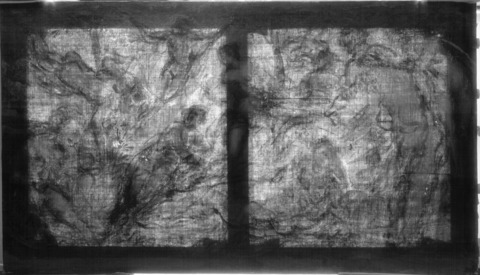

Description of Paint
Analyzed Observed
Application and Technique:
The paint layer has been roughly applied with more delicate rendering in the faces. There are several areas of scumbling, where the paint was applied with a dry brush, skimming the surface and picking up the texture of the twill canvas (this is further accentuated by abrasion). Strong brown outlines surround the figures, reinforcing their shapes. Much of the composition contains sweeping brushstrokes that have been swiftly applied. The torsos of most of the figures are twisting to some extent; when combined with the brushwork, the overall effect gives a sense of movement to the painting. The painting is diagonally dissected by areas of light and dark, with the upper left being the lightest and the lower right being the darkest.
The unfinished quality and small size of Apollo and the Muses suggest that it was a copy after the larger Royal Collection version, or another now lost copy, rather than a finished work. This practice of copying was common to the Tintoretto studio (see Entry). This is supported by the sketchy nature of the underdrawing, as seen in infrared reflectography and transmitted infrared (tech. figs. 19, 20).
The painting’s history is well documented, and it was featured as an engraving by Nicolaus van Hoy in David Teniers the Younger’s Theatrum Pictorium (Antwerp, 1660). This document recorded the most admired Italian paintings belonging to Archduke Leopold Wilhelm of Austria (tech. fig. 22).
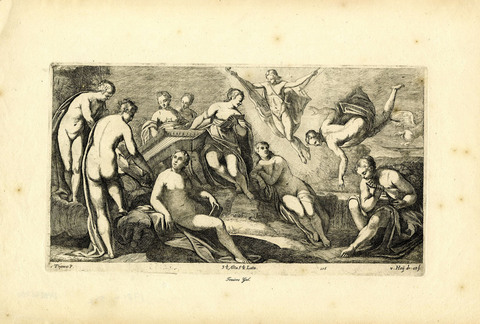
Painting Tools:
Brushes of varying sizes, no evidence of palette knife or other hard-edged tools
Binding Media:
Oil (untested)
Color Palette:
The color palette is limited, consisting primarily of earth pigments, skin tones, and blues in the figures' robes and sky. A few areas of bright red highlights are present on the figures' faces. XRF analysis was conducted in several areas of the painting to determine possible pigments used. The analysis indicates pigments that are consistent with sixteenth-century Italian painting and correspond to what would have been present in an Italian workshop from this period. Raman microspectroscopy confirmed the presence of ultramarine blue in a sample from a blue robe.
Cross section 1 includes a layer of sky paint (layer 5) with a large bone black particle (containing both calcium and phosphorous, tech. figs. 24, 25). This layer also contains a significant proportion of lead (tech. fig. 26). This suggests the bluish color may have been created by applying a mixture of lead white and bone black over a dark brown imprimatura (see Description of Ground). When light paint is applied over a dark imprimatura (tech. fig. 23, layer 2) the turbid medium effect enhances the cool, bluish appearance. Elemental markers for ultramarine blue, such as sodium and aluminum, were not detected in this layer nor was copper. However, it is possible that indigo was used to enhance the blue appearance or that a small amount of ultramarine was also added to the sky but was not present in this sample.


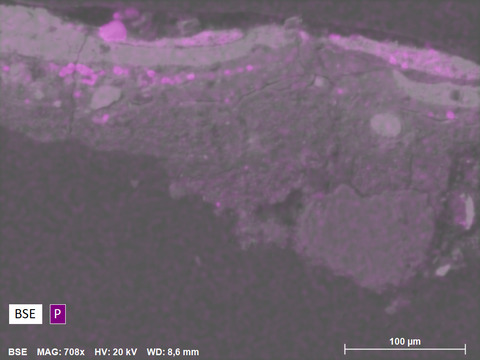
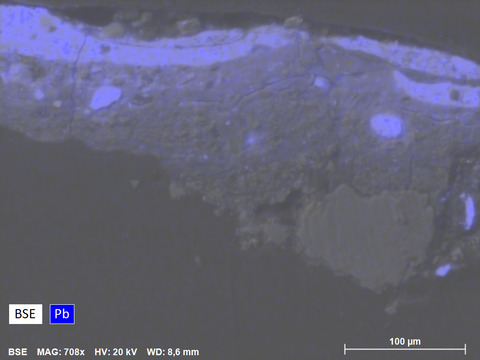
XRF Analysis:
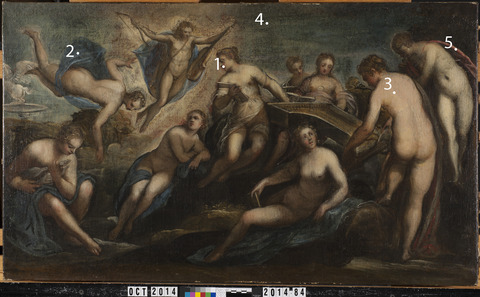
| Sample | Location | Elements | Possible Pigments |
|---|---|---|---|
| 1 | Red on lips | Major: Hg, Pb Minor: Fe, Ca Trace: | Vermilion, lead white, iron oxide (earth pigments), calcium (likely from ground layer). |
| 2 | Blue in robe | Major: Pb, Fe, Ca Minor: Cu Trace: Hg, Mn, K, Ti | Lead white, iron oxide (earth pigments including umber), calcium (likely from ground layer), copper-containing green and/or blue pigment, trace of vermilion. |
| 3 | Skin tone, woman on right | Major: Pb Minor: Hg, Ca, Fe Trace: | Lead white, vermilion, iron oxide (earth pigments), calcium (likely from ground layer). |
| 4 | Greenish-blue background | Major: Pb Minor: Ca, Fe, Cu Trace: Cu | Lead white, calcium (likely from ground layer), iron oxide (earth pigments), copper-containing green and/or blue pigment, |
| 5 | Red robe left Muse | Major: Pb, Hg Minor: Fe, Ca Trace: Cu, Mn, Ti | Vermilion, lead white, iron oxide (earth pigments), calcium (likely from ground layer), possible red lake pigment (not detectable using XRF) |
Table 1: Results of X-ray fluorescence analysis conducted with a Bruker Artax microfocus XRF with rhodium tube, silicon-drift detector, and polycapillary focusing lens (~100μm spot).
*Major, minor, trace quantities are based on XRF signal strength not quantitative analysis
Surface Appearance:
The paint appears to be relatively thin, with no areas of impasto. There are significant areas of retouching visible, which have clearly discolored, leaving an uneven and damaged look to the painting. The paint appears slightly yellow due to discolored varnish over the surface.
Condition of Paint
A craquelure pattern, from natural aging, extends over the entire painting (tech. fig. 28). Small paint losses are scattered throughout. Some wear is visible around the perimeter of the painting where the paint is in contact with the frame. Some of the paint has been heavily abraded (tech. fig. 29), likely from previous invasive cleanings, revealing the underlying paint layers. This is particularly noticeable in the white area of the sky, where the reddish imprimatura layer can be easily seen due to the abrasion. Significant losses of paint are present around all edges and have subsequently been filled and painted. Pinpoint losses are also present throughout much of the painting.
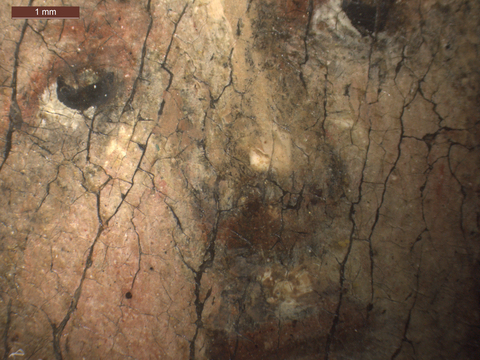
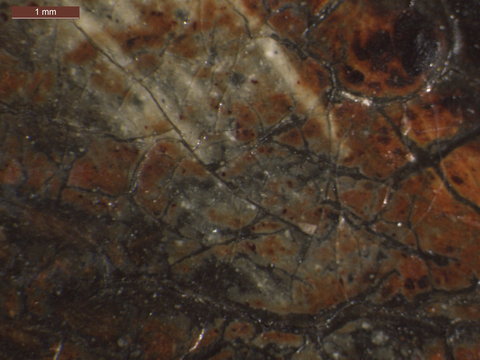
Description of Varnish/Surface Coating
Analyzed Observed Documented
| Type of Varnish | Application |
|---|---|
| Natural resin | Spray applied |
| Synthetic resin/other | Brush applied |
| Multiple Layers observed | Undetermined |
| No coating detected |

When viewed under ultraviolet-induced visible fluorescence, the fluorescence on the painting is consistent with a coating of aged, natural-resin varnish (tech. fig. 30). This coating appears to be present over the entire surface of the painting. The painting appears to have slightly yellowed, and some aged varnish has pooled in the valleys of the canvas weave emphasizing the texture. Evidence of previous restoration campaigns in the form of large amounts of retouching is present across the painting and around the edges where much of the original paint is no longer present.
Condition of Varnish/Surface Coating
The natural resin varnish has yellowed over time, giving the painting a green appearance in the areas of blue paint. A few scuffs and abrasions are noticeable along the perimeter of the painting, likely due to contact with the frame. Some of the retouching is discolored and no longer matches the surrounding original paint layer.
Description of Frame
Original/first frame
Period frame
Authenticity cannot be determined at this time/ further art historical research necessary
Reproduction frame (fabricated in the style of)
Replica frame (copy of an existing period frame)
Modern frame
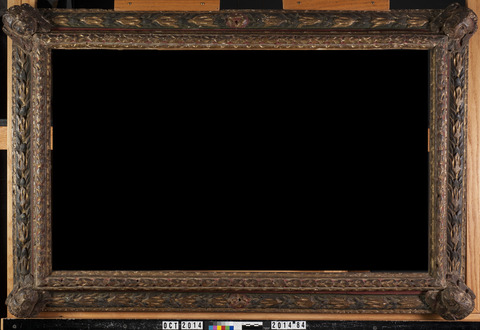
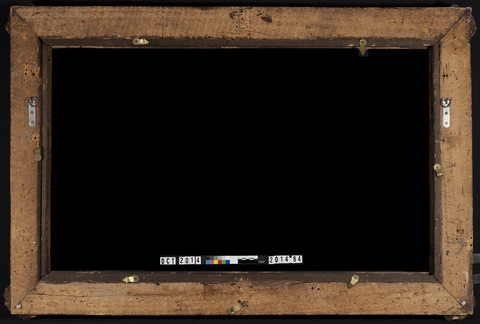
Frame Dimensions:
Outside frame dimensions: 78 × 117 × 8 cm
Sight size: 54 × 93 cm
Distinguishing Marks:
Item 10. Stamp, slightly legible on bottom member: “216_” (possibly 2160, 2166 or 2188) (tech. fig. 32).
Description of Molding/Profile:
Frame specialist Timothy Newbery suggests the frame originated from Venice in about 1640 (tech. fig. 31).7 It is constructed from carved poplar and is painted in polychrome with red, white, and blue green (tech. fig. 33). The four corners have angel heads, and the frame exhibits lotus leaves derived from Sansovino style as well as husks.8 It is possible that the frame was a small ceiling frame. The sight size of the frame was reduced at the corners.9
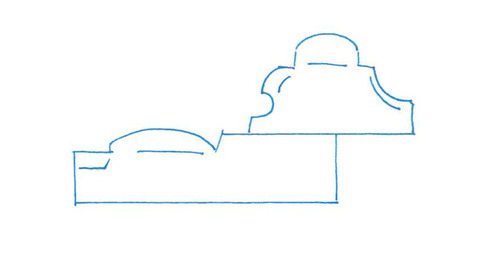
Condition of Frame
The frame is in relatively good condition. There is general wear throughout and several areas of flaking gesso that require consolidation. These areas appear to have been present for a long time. No recent damage is visible.
Notes
-
Paul A.J. Spheeris, “Conservation Report on the Condition of the Clowes Collection,” 25 October 1971, Conservation Department Files, Indianapolis Museum of Art at Newfields. ↩︎
-
Martin Radecki, Clowes Collection condition assessment, undated (after October 1971), Conservation Department Files, Indianapolis Museum of Art at Newfields. ↩︎
-
Intermuseum Conservation Association, “Clowes Collection Conservation Report,” C10073 (2014.82), 8–10 April 1974, Conservation Department Files, Indianapolis Museum of Art at Newfields. ↩︎
-
J. Plesters, “Tintoretto's Paintings in the National Gallery: Part II,” National Gallery Technical Bulletin 4 (1980): 39–40, http://www.nationalgallery.org.uk/technical-bulletin/plesters1980. ↩︎
-
Jill Dunkerton and Marika Spring, “The Development of Painting on Coloured Surfaces in Sixteenth-Century Italy,” Studies in Conservation 43:sup1 (1998): 125, 10.1179/sic.1998.43.Supplement-1.120. ↩︎
-
J. Plesters, “Tintoretto's Paintings in the National Gallery: Part II,” National Gallery Technical Bulletin 4 (1980): 39–40, http://www.nationalgallery.org.uk/technical-bulletin/plesters1980. ↩︎
-
Timothy Newbery, frame specialist, London, England. Visual analysis completed at the Indianapolis Museum of Art, 19 January 2012. ↩︎
-
Sixteenth-century Italian sculptor and architect Jacobo Sansovino’s buildings were influential in decorative arts. Encyclopaedia Britannica, s.v. “Jacopo Sansovino.” 23 November 2021, https://www.britannica.com/biography/Jacopo-Sansovino. ↩︎
-
Timothy Newbery, frame specialist, London, England. Visual analysis completed at the Indianapolis Museum of Art, 19 January 2012. ↩︎
Additional Images
